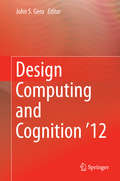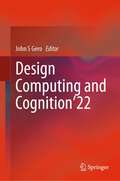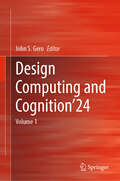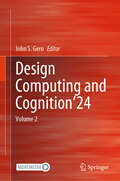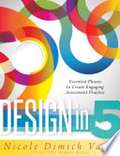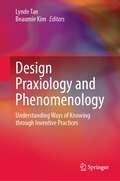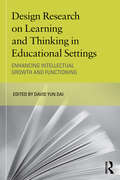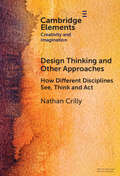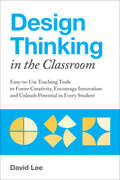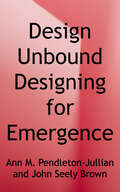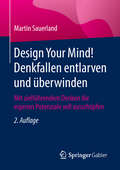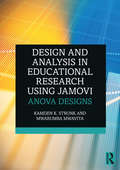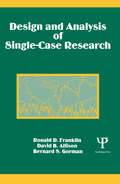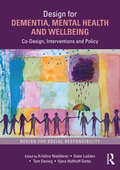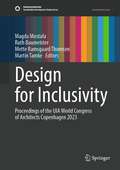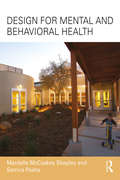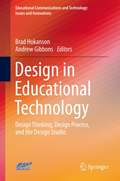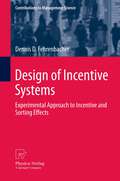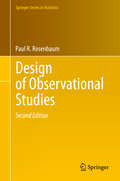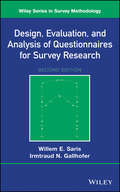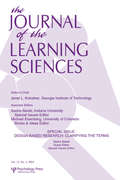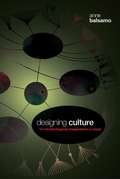- Table View
- List View
Design Computing and Cognition '12
by John S. GeroDesign thinking, the label given to the acts of designing, has become a paradigmatic view that has transcended the discipline of design and is now widely used in business and elsewhere. As a consequence there is an increasing interest in design research. This is because of the realization that design is part of the wealth creation of a nation and needs to be better understood and taught. The continuing globalization of industry and trade has required nations to re-examine where their core contributions lie if not in production efficiency. Design is a precursor to manufacturing for physical objects and is the precursor to implementation for virtual objects. At the same time, the need for sustainable development requires the design of new products and processes, which feeds a movement towards design innovations and inventions. The papers in this volume are from the Fifth International Conference on Design Computing and Cognition (DCC'12) held at Texas A & M University, USA. They represent the state-of-the-art of research and development in design computing and design cognition. They are of particular interest to researchers, developers and users of advanced computation in design and those who need to gain a better understanding of designing.
Design Computing and Cognition’20
by John S. GeroThe papers in this volume are from the Ninth International Conference on Design Computing and Cognition (DCC’20) held virtually at the Georgia Institute of Technology, Atlanta, USA. They represent the state-of-the-art of research and development in design computing and design cognition including the increasingly active area of design cognitive neuroscience. They are of particular interest to design researchers, developers and users of advanced computation in designing as well as to design educators. This volume contains knowledge about the cognitive behavior of designers, which is valuable for those who need to gain a better understanding of designing.
Design Computing and Cognition’22
by John S GeroThis book reports research and development that represent the state of the art in artificial intelligence in design, design cognition, design neurocognition, and design theories from the Tenth International Conference on Design Computing and Cognition held in Glasgow, UK, in 2022. The 48 chapters are grouped under the headings of natural language processing and design; design cognition; design neurocognition; learning and design; creative design and co-design; shape grammars; quantum computing; and human behavior. These contributions are of particular interest to design researchers and design educators, as well as to users of advanced computation and cognitive science. This book contains knowledge about the cognitive and neurocognitive behavior of designers, which is valuable to those who need to gain a better understanding of designing.
Design Computing and Cognition’24: Volume 1
by John S. GeroThis book publishes the reviewed and revised texts of the papers delivered at the Eleventh International Conference on Design Computing – DCC’24 held at Concordia University in Montreal, Canada. These papers span the range of design research from artificial intelligence, cognitive science, cognitive neuroscience to computational theories applies to design. The papers are published in two volumes and are grouped under the following headings: Design Processes, Design Creativity, Design Cognition, Shape and Form, Design Technology, AI and Design, Design and Brain Behaviors, and Design AI Applications. These two volumes form an archival record of current cutting-edge research studying design scientifically. They demonstrate the range of approaches being used to characterize designing as a process. At the same time they show that there is a commonality in designing independent of design discipline. These volumes will be of interest to design researchers in both academia and industry and to anyone who needs to obtain a better understanding of designing.
Design Computing and Cognition’24: Volume 2
by John S. GeroThis book publishes the reviewed and revised texts of the papers delivered at the Tenth International Conference on Design Computing – DCC’24 held at Concordia University in Montreal, Canada. These papers the range of design research from artificial intelligence, cognitive science, cognitive neuroscience and computational theories applies to design. The papers are published in two volumes and are grouped under the following headings: Design Processes, Design Creativity, Design Cognition, Shape and Form, Design Technology, AI and Design, Design and Brain Behaviors, and Design AI Applications. These two volumes form an archival record of then current cutting-edge research studying design scientifically. They demonstrate the range of approaches being used to characterize designing as a process. At the same time they show that there is a commonality in designing independent of design discipline. These volumes will be of interest to design researchers in both academia and industry and to anyone who needs to obtain a better understanding of designing.
Design Education: A Special Issue of the Journal of the Learning Sciences
by Janet L. KolodnerThis is Volume 9, Number 3 (2000) special issue of the Journal of Learning Sciences and focuses on Design Education. Design as a vehicle for applying and extending content knowledge is central to engineering education. In this issue the reader is offered three articles on middle- school-age children learning in the context of design. Two articles report on research projects in in formal educational settings with large numbers of students; the other chronicles one girl’s learning over a weekend in an informal online setting.
Design In Five: Essential Phases To Create Engaging Assessment Practice
by Nicole Dimich VagleFully engage learners in your classroom. Discover how to create high-quality assessments using a five-phase design protocol. Explore types and traits of quality assessment, and learn how to develop assessments that are innovative, effective, and engaging. Evaluate whether your current assessments meet the design criteria, and discover how to use this process collaboratively with your team.
Design Praxiology and Phenomenology: Understanding Ways of Knowing through Inventive Practices
by Beaumie Kim Lynde TanThis book offers insight into designerly ways of knowing from the perspectives of experts and professionals engaging in diverse forms of design in workplaces and other public domains. It also aids in the understanding of design practices from designers’ viewpoints via case studies. By pursuing a reflective inquiry in their design epistemology (designerly ways of knowing), design praxiology (practices of design), or design phenomenology (forms of designs), self-studies of design practices, and presenting studies of designs, the authors of this book demonstrate how they influence the people and the object of inquiry or design. The case studies presented in this book also illustrate how designers develop their expertise, and provides inspiration for the incorporation of design-thinking and practice in education.
Design Research on Learning and Thinking in Educational Settings: Enhancing Intellectual Growth and Functioning (Educational Psychology Series)
by David Yun DaiThe key question this book addresses is how to identify and create optimal conditions for the kind of learning and development that is especially important for effectively functioning in the 21st century. Taking a new approach to this long-debated issue, it looks at how a design research-based science of learning (with its practical models and related design research) can provide insights and integrated models of how human beings actually function and grow in the social dynamics of educational settings with all their affordances and constraints. More specifically: How can specific domains or subject matters be taught for broad intellectual development? How can technology be integrated in enhancing human functioning? How can the social organization of classroom learning be optimized to create social norms for promoting deep intellectual engagement and personal growth? Part I is concerned with broad conceptual and technical issues regarding cultivating intellectual potential, with a focus on how design research might fill in an important a niche in addressing these issues. Part II presents specific design work in terms of design principles, models, and prototypes.
Design Thinking and Other Approaches: How Different Disciplines See, Think and Act (Elements in Creativity and Imagination)
by Nathan CrillyEfforts to promote creativity often centre on encouraging people to engage in 'design thinking', 'systems thinking' and 'entrepreneurial thinking'. These different approaches are most often defined, taught and applied in mutual isolation, which has obscured what distinguishes them from each other, what they have in common and how they might be combined. These three approaches are also most often described in isolation from the approaches that characterize other disciplines, all of which are relevant to how problems are identified, framed and solved. These other approaches include 'computational thinking', 'engineering thinking', 'scientific thinking', 'evolutionary thinking', 'mathematical thinking', 'statistical thinking', 'geographical thinking', 'historical thinking', 'anthropological thinking' and many more. Examining these approaches as a set allows each of them to be better understood, and also reveals the connections and contrasts between them. Such comparisons provide the foundation for a more coordinated project to represent how different disciplinary approaches contribute to creative work.
Design Thinking in the Classroom: Easy-to-Use Teaching Tools to Foster Creativity, Encourage Innovation and Unleash Potential in Every Student (Books for Teachers)
by David LeeA teacher’s guide to empowering students with modern thinking skills that will help them throughout life.Design thinking is a wonderful teaching strategy to inspire your students and boost creativity and problem solving. With tips and techniques for teachers K through 12, this book provides all the resources you need to implement Design Thinking concepts and activities in your classroom right away. These new techniques will empower your students with the modern thinking skills needed to succeed as they progress in school and beyond.These easy-to-use exercises are specifically designed to help students learn lifelong skills like creative problem solving, idea generation, prototype construction, and more. From kindergarten to high school, this book is the perfect resource for successfully implementing Design Thinking into your classroom.
Design Unbound: Designing for Emergence in a White Water World, Volume 1 (Infrastructures Series)
by John Seely Brown Ann Pendleton-JullianThis book presents a new tool set for having agency in the twenty-first century, in what the authors characterize as a white water world-rapidly changing, hyperconnected, and radically contingent. These are the tools of a new kind of practice that is the offspring of complexity science, which gives us a new lens through which to view the world as entangled and emerging, and architecture, which is about designing contexts. <p><p>In such a practice, design, unbound from its material thingness, is set free to design contexts as complex systems. In a world where causality is systemic, entangled, in flux, and often elusive, we cannot design for absolute outcomes. Instead, we need to design for emergence. This book not only makes this case through theory but also presents a set of tools to do so. <p><p>With case studies that range from a new kind of university to organizational, and even societal, transformation, the book draws from a vast array of domains- architecture, science and technology, philosophy, cinema, music, literature and poetry, even the military. It is presented in five books, bound as two volumes. Different books within the larger system of books will resonate with different reading audiences, from architects to people reconceiving higher education to the public policy or defense and intelligence communities. The authors provide different entry points allowing readers to navigate their own pathways through the system of books.
Design Your Mind! Denkfallen entlarven und überwinden
by Martin SauerlandDas Denken in Schwarz-Weiß-Kategorien oder in Konjunktiven, übertriebener Perfektionismus oder der ständige Vergleich mit anderen – wer kennt derartige Denkfallen nicht. Denkmuster dieser Art begegnen uns jeden Tag und beeinträchtigen unsere Denkprozesse und unsere Produktivität.In wissenschaftlichen Studien hat der Autor die häufigsten Denkfallen systematisch untersucht und beschrieben. Mit kurzen Selbsttests können diese schnell erkannt werden. Darauf aufbauend gibt er praktische Lösungswege an die Hand, mit denen die gelernten Denkmuster überwunden werden können. Eigene Potenziale werden so besser genutzt, die Entscheidungsqualität wird verbessert und die Toleranz für Belastungen steigt.Dysfunktionale Denkstile wirken sich auch auf dysfunktionale Entscheidungsstile aus: Entscheidungen werden häufig zu lange aufgeschoben, auf andere Personen abgeschoben oder es wird impulsiv oder sogar defensiv entschieden. Darüber hinaus beeinflussen tief verwurzelte Glaubenssysteme zum Thema Geld, wie z.B. Schulden sind etwas Schlechtes, die Lebensführung vieler Menschen. Diese beiden Themenfelder wurden in der zweiten Auflage ergänzt.
Design and Analysis in Educational Research Using jamovi: ANOVA Designs
by Kamden K. Strunk Mwarumba MwavitaDesign and Analysis in Educational Research Using jamovi is an integrated approach to learning about research design alongside statistical analysis concepts. Strunk and Mwavita maintain a focus on applied educational research throughout the text, with practical tips and advice on how to do high-quality quantitative research. Based on their successful SPSS version of the book, the authors focus on using jamovi in this version due to its accessibility as open source software, and ease of use. The book teaches research design (including epistemology, research ethics, forming research questions, quantitative design, sampling methodologies, and design assumptions) and introductory statistical concepts (including descriptive statistics, probability theory, sampling distributions), basic statistical tests (like z and t), and ANOVA designs, including more advanced designs like the factorial ANOVA and mixed ANOVA. This textbook is tailor-made for first-level doctoral courses in research design and analysis. It will also be of interest to graduate students in education and educational research. The book includes Support Material with downloadable data sets, and new case study material from the authors for teaching on race, racism, and Black Lives Matter, available at www.routledge.com/9780367723088.
Design and Analysis of Single-Case Research
by David B. Allison Ronald D. Franklin Bernard S. GormanThis book focuses on one important aspect of psychological research -- the intensive study of people measured one or more at a time. Some important historical material is detailed in several chapters making a strong connection to previous material in psychology. Several contributors present important details on classical and novel methods to study behavior over time, and they do so in the context of appropriate statistical methods. This appropriately reflects the growing interest in examining dynamic behaviors by objective measurement. Key experimental design principles are expertly stated, reflecting the growing interest in studying the individual course of development for invariants in behaviors, including some unusual constructs such as cycles and punctuated equilibria. This book also deals with practical contemporary problems in psychology and documents the increased possibility of using clinical research tools. Taken as a whole, this volume is filled with interesting historical points, informative mathematical and statistical analyses, and practical methods. It is the only book addressing the issues of meta-analysis, cyclicity, and confounds to visual inspection of single subject data that considers ways in which statistical software can aid in overcoming these constraints.
Design for Dementia, Mental Health and Wellbeing: Co-Design, Interventions and Policy (Design for Social Responsibility)
by Kristina Niedderer, Geke Ludden, Tom Dening and Vjera Holthoff-DettoThis edited volume offers the first overview and reflective discussion of how design can contribute to people’s wellbeing and mental health in the context of dementia, mental illness and neurodiversity. This book explores and promotes holistic, salutogenic and preventive strategies that recognise and respond to people’s needs, wants, wishes and rights to further health, wellbeing and equality. Bringing together years of experience as designers and clinicians, the contributors to the book emphasise how design can be a collaborative, creative process as well as an outcome of this process, and they reveal how this is guided by mental health and design policy. Through its three parts, the book explores themes of ethics, citizenship and power relationships in co-design, providing an overview of current developments and approaches in co-design; of the culturally and value sensitive adaptation of design interventions and their applications, many of which are a result of co-design; and of policy and related standards in and for design and mental health. In this way, the book demonstrates how design can help to support people, their care partners and care professionals in promoting mental health and wellbeing, and it offers a rich resource on how to create a sustainable future for care in this domain. The book provides a unique and holistic overview and resource for designers, researchers, students, policy providers and health and care professionals to help support the development and adoption of person-centred design processes and interventions.
Design for Inclusivity: Proceedings of the UIA World Congress of Architects Copenhagen 2023 (Sustainable Development Goals Series)
by Mette Ramsgaard Thomsen Martin Tamke Magda Mostafa Ruth BaumeisterThe book provides new perspectives from leading experts examining the role of architects and urbanists in designing for inclusivity in our built environment. By focusing on themes of gender, race and ethnicity, ability, neurodiversity, age, poverty and socio-economy and the non-human, the book tackles the complex challenges that designers and scholars encounter and need to address in their works. The volume offers a diverse compilation of peer-reviewed papers related to architecture for inclusivity in various different formats, ranging from visual essays, argumentative papers and scholastic texts. It presents the notion of "availability", a concept which works to challenge the "othering" inherent in notions of inclusion and accessibility. In its introduction it presents a critical discourse around the challenges and potentials lying in the design for availability targeted towards a systemic change of our societies. The book is part of a series of six volumes that explore the agency of the built environment in relation to the SDGs through new research conducted by leading researchers. The series is led by editors Mette Ramsgaard Thomsen and Martin Tamke in collaboration with the theme editors: - Design for Climate Adaptation: Billie Faircloth and Maibritt Pedersen Zari - Design for Rethinking Resources: Carlo Ratti and Mette Ramsgaard Thomsen (Eds.) - Design for Resilient Communities: Anna Rubbo and Juan Du (Eds.) - Design for Health: Arif Hasan and Christian Benimana (Eds.) - Design for Inclusivity: Magda Mostafa and Ruth Baumeister (Eds.) - Design for Partnerships for Change: Sandi Hilal and Merve Bedir (Eds.)
Design for Mental and Behavioral Health
by Mardelle McCuskey Shepley Samira PashaStudies confirm that the physical environment influences health outcomes, emotional state, preference, satisfaction and orientation, but very little research has focused on mental and behavioural health settings. This book summarizes design principles and design research for individuals who are intending to design new mental and behavioural health facilities and those wishing to evaluate the quality of their existing facilities. The authors discuss mental and behavioural health systems, design guidelines, design research and existing standards, and provide examples of best practice. As behavioural and mental health populations vary in their needs, the primary focus is limited to environments that support acute care, outpatient and emergency care, residential care, veterans, pediatric patients, and the treatment of chemical dependency.
Design for a Better Future: A guide to designing in complex systems
by John Body Nina TerreyThe world we live in is increasingly complex. It throws up complex problems. This book is about tackling them. <P><P> At ThinkPlace, we’ve pioneered the application of design thinking to complex challenges like climate change, family violence and global malnutrition. We work globally with governments, organisations and communities using a methodology – the Design System™ outlined in this book – that has been developed over more than a decade. <P><P> We bring together different voices and help them to create better futures. If you’re one of those voices, or would like to be, this book is for you. It’s part roadmap, part instruction manual, but mostly it’s a clarion call for a new way of doing things: tackling the world’s biggest problems in a way that brings people together and produces positive, lasting change.
Design in Educational Technology: Design Thinking, Design Process, and the Design Studio
by Brad Hokanson Andrew GibbonsThis book is the result of a research symposium sponsored by the Association for Educational Communications and Technology [AECT]. The fifteen chapters were developed by leaders in the field and represent the most updated and cutting edge methodology in the areas of instructional design and instructional technology. The broad concepts of design, design thinking, the design process, and the design studio, are identified and they form the framework of the book. This book advocates the conscious adoption of a mindset of design thinking, such as that evident in a range of divergent professions including business, government, and medicine. At its core is a focus on "planning, inventing, making, and doing." (Cross, 1982), all of which are of value to the field of educational technology. Additionally, the book endeavors to develop a deep understanding of the design process in the reader. It is a critical skill, often drawing from other traditional design fields. An examination of the design process as practiced, of new models for design, and of ways to connect theory to the development of educational products are all fully explored with the goal of providing guidance for emerging instructional designers and deepening the practice of more advanced practitioners. Finally, as a large number of leading schools of instructional design have adopted the studio form of education for their professional programs, we include this emerging topic in the book as a practical and focused guide for readers at all levels.
Design of Incentive Systems: Experimental Approach to Incentive and Sorting Effects
by Dennis D. FehrenbacherMonetary incentives, as a driving force for human behavior, are the main theme of this book. The primary goals underlying the application of monetary incentive systems in companies are motivating employees to strive for superior productivity in line with the interests of employers, and hiring adequately skilled employees. The first goal refers to incentive effects, the latter to sorting effects. This book introduces important theories and concepts concerning behavior under influence of monetary incentives; it reviews existing economic frameworks and identifies specific contingency variables. Based on an integrative framework of elements influencing incentive and sorting effects, a laboratory experiment is presented including detailed methodological discussion on experimentation and data analysis as well as an extensive presentation of findings and discussion of implications.
Design of Observational Studies (Springer Series in Statistics)
by Paul R. RosenbaumThis second edition of Design of Observational Studies is both an introduction to statistical inference in observational studies and a detailed discussion of the principles that guide the design of observational studies. An observational study is an empiric investigation of effects caused by treatments when randomized experimentation is unethical or infeasible. Observational studies are common in most fields that study the effects of treatments on people, including medicine, economics, epidemiology, education, psychology, political science and sociology. The quality and strength of evidence provided by an observational study is determined largely by its design. Design of Observational Studies is organized into five parts. Chapters 2, 3, and 5 of Part I cover concisely many of the ideas discussed in Rosenbaum’s Observational Studies (also published by Springer) but in a less technical fashion. Part II discusses the practical aspects of using propensity scores and other tools to create a matched comparison that balances many covariates, and includes an updated chapter on matching in R. In Part III, the concept of design sensitivity is used to appraise the relative ability of competing designs to distinguish treatment effects from biases due to unmeasured covariates. Part IV is new to this edition; it discusses evidence factors and the computerized construction of more than one comparison group. Part V discusses planning the analysis of an observational study, with particular reference to Sir Ronald Fisher’s striking advice for observational studies: "make your theories elaborate." This new edition features updated exploration of causal influence, with four new chapters, a new R package DOS2 designed as a companion for the book, and discussion of several of the latest matching packages for R. In particular, DOS2 allows readers to reproduce many analyses from Design of Observational Studies.
Design, Evaluation, and Analysis of Questionnaires for Survey Research
by Willem E. Saris Irmtraud N. GallhoferDesign, Evaluation, and Analysis of Questionnaires for Survey Research, Second Edition explores updates on the statistical knowledge and development of survey questionnaires, including analyzing the important decisions researchers make throughout the survey design process. The new edition provides coverage of an updated SQP program, which has an expanded question database from the Multi-trait Multi-method (MTMM) experiments. This book aims to give students and survey researchers a state-of-the-art introduction to questionnaire design and how to construct questionnaires with the highest relevance and accuracy. The pitfalls of questionnaire design are outlined throughout the book, which alerts designers of questionnaires to the many prior decisions that will affect the quality of the research outcome. It is important to measure the quality of questions at the outset in order for students and researchers to consider the consequences and methods of achieving reliable and effective questions.
Design-based Research: Clarifying the Terms. A Special Issue of the Journal of the Learning Sciences
by Sasha BarabOver a decade ago the concept of "design experiments" was introduced because of the belief that many of questions could not be adequately addressed by laboratory-based experiments. Since then, design-based research as a term has grown in popularity and significance. The core manuscripts of this special issue respond to the questions: What constitutes design-based research? Why is it important? What are the methods to carry it out? At the end of this issue, two strong commentaries situate this work and challenge the community with new questions and issues that must be answered if design-based research is going to help advance work in ways that others judge as worthwhile and significant.
Designing Culture: The Technological Imagination at Work
by Anne BalsamoThe renowned cultural theorist and media designer Anne Balsamo maintains that technology and culture are inseparable; those who engage in technological innovation are designing the cultures of the future. Designing Culture is a call for taking culture seriously in the design and development of innovative technologies. Balsamo contends that the wellspring of technological innovation is the technological imagination, a quality of mind that enables people to think with technology, to transform what is known into what is possible. She describes the technological imagination at work in several multimedia collaborations in which she was involved as a designer or developer. One of these entailed the creation of an interactive documentary for the NGO Forum held in conjunction with the UN World Conference on Women in Beijing in 1995. (That documentary is included as a DVD in Designing Culture. ) Balsamo also recounts the development of the interactive museum exhibit XFR: Experiments in the Future of Reading, created by the group RED (Research in Experimental Documents) at Xerox PARC. She speculates on what it would mean to cultivate imaginations as ingenious in creating new democratic cultural possibilities as they are in creating new kinds of technologies and digital media. Designing Culture is a manifesto for transforming educational programs and developing learning strategies adequate to the task of inspiring culturally attuned technological imaginations.
